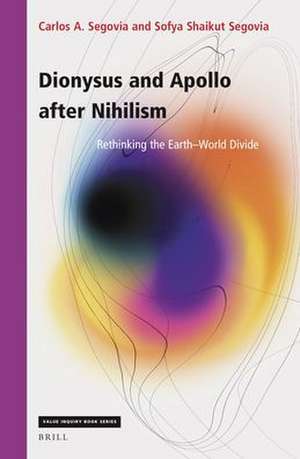Dionysus and Apollo after Nihilism: Rethinking the Earth–World Divide: Value Inquiry Book Series / Studies in Existentialism, Hermeneutics, and Phenomenology, cartea 384
Autor Carlos A. Segovia, Sofya Shaikut Segoviaen Limba Engleză Hardback – 23 feb 2023
Preț: 750.80 lei
Preț vechi: 915.61 lei
-18% Nou
Puncte Express: 1126
Preț estimativ în valută:
143.68€ • 148.43$ • 119.58£
143.68€ • 148.43$ • 119.58£
Carte indisponibilă temporar
Doresc să fiu notificat când acest titlu va fi disponibil:
Se trimite...
Preluare comenzi: 021 569.72.76
Specificații
ISBN-13: 9789004538580
ISBN-10: 9004538585
Pagini: 276
Dimensiuni: 155 x 235 mm
Greutate: 0 kg
Editura: Brill
Colecția Brill
Seria Value Inquiry Book Series / Studies in Existentialism, Hermeneutics, and Phenomenology
ISBN-10: 9004538585
Pagini: 276
Dimensiuni: 155 x 235 mm
Greutate: 0 kg
Editura: Brill
Colecția Brill
Seria Value Inquiry Book Series / Studies in Existentialism, Hermeneutics, and Phenomenology
Notă biografică
Carlos A. Segovia (Ph.D., Philosophy, Complutense University of Madrid, 2004) is lecturer of philosophy at Saint Louis University, Madrid Campus. He is the editor of Conceptual Personae in Ontology (2022) and the author of Nietzsche’s Pre-Dionysian Apollo and the Limits of Contemporary Thought (forthcoming).
Sofya Shaikut Segovia is a performance artist and a philosopher. She teaches butō dance in Madrid while studying with Sayoko Onishi. She is also a co-editor of From Worlds of Possibles to Possible Worlds: On Post-Nihilism and Dwelling (2021).
Sofya Shaikut Segovia is a performance artist and a philosopher. She teaches butō dance in Madrid while studying with Sayoko Onishi. She is also a co-editor of From Worlds of Possibles to Possible Worlds: On Post-Nihilism and Dwelling (2021).
Recenzii
"This book reappraises the quality of Apollo as a conceptual and political necessity for a world whose nightmarish master signifier, and rule in the end, is one of instability, crisis, war, and – to use another important concept in this book – nihilism. Even chaos needs a form of meta-stability to display its beauty."– Frédéric Neyrat, University of Wisconsin-Madison
"Dionysus and Apollo after Nihilism is an ambitious and timely intervention in the contemporary philosophical scene. Rich with insight and erudition, this book is a significant contribution to recasting critical diagnoses of the present and explorations 'otherwise' within the differential terrain of ontological pluralism."– Jarrad Reddekop, Camosun College
"Dionysus and Apollo after Nihilism is an ambitious and timely intervention in the contemporary philosophical scene. Rich with insight and erudition, this book is a significant contribution to recasting critical diagnoses of the present and explorations 'otherwise' within the differential terrain of ontological pluralism."– Jarrad Reddekop, Camosun College
Cuprins
List of Figures
1Introduction
1 The Idea behind This Book
2 Mapping the Issues
3 Brief Outline of the Book’s Chapters and Their Sources
4 A Note on Style, Translations, and Conventions
2Dionysus in Greece
1 Untamed Life
2 An Olympian God?
3 The Unity of the Living
4 An Integrative God
5 Dionysus and Ontology
3The Greek Apollo
1 Apollo’s Gaze
2 Apollo’s Distance
3 Apollo’s Arrows
4 Apollo and the Birth of Philosophy
5 Apollo, Dionysus, and the Earth
4The Modern Misadventures of Apollo and Dionysus
1 Achilles and Odysseus
2 Nietzsche’s Dionysian Philosophy
3 Dionysus’s Maelstrom
4 Winckelmann’s Apollo
5 A Queer Ideal?
6 Dionysus’s Bequest
5Thinking with Apollo
1 Apollo’s Marble
2 Apollo’s Stereogram
3 Apollo’s Screen
4 Apollo’s Blackout
5 Apollo’s Silence
6 Wordling(s): the Earth’s Reflexivity
6Dancing with Dionysus
1 Our Living Body
2 The Purpose of Dancing
3 Artaud and Hijikata
4Butō: Animism redux
5 Intersections
6 A Twofold Legacy
7Back to Structuralism?
1 Structuralism as a Philosophy of Difference
2 The Post-structuralist Waterline
3 Ontological Pluralism and the Neo-structuralist Worlding Star
8Conclusion: Post-metaphysics and Its Doubles
1 On Post-nihilism and the Subject/Object Divide
2 Destiny and the Otherwise
3 Dionysus and Apollo, Twins
4 À rebours
Appendix 1: Development of the Ontological Pentagram
Appendix 2: Development of the Modal Pentagram
Bibliography
Index
1Introduction
1 The Idea behind This Book
2 Mapping the Issues
3 Brief Outline of the Book’s Chapters and Their Sources
4 A Note on Style, Translations, and Conventions
2Dionysus in Greece
1 Untamed Life
2 An Olympian God?
3 The Unity of the Living
4 An Integrative God
5 Dionysus and Ontology
3The Greek Apollo
1 Apollo’s Gaze
2 Apollo’s Distance
3 Apollo’s Arrows
4 Apollo and the Birth of Philosophy
5 Apollo, Dionysus, and the Earth
4The Modern Misadventures of Apollo and Dionysus
1 Achilles and Odysseus
2 Nietzsche’s Dionysian Philosophy
3 Dionysus’s Maelstrom
4 Winckelmann’s Apollo
5 A Queer Ideal?
6 Dionysus’s Bequest
5Thinking with Apollo
1 Apollo’s Marble
2 Apollo’s Stereogram
3 Apollo’s Screen
4 Apollo’s Blackout
5 Apollo’s Silence
6 Wordling(s): the Earth’s Reflexivity
6Dancing with Dionysus
1 Our Living Body
2 The Purpose of Dancing
3 Artaud and Hijikata
4Butō: Animism redux
5 Intersections
6 A Twofold Legacy
7Back to Structuralism?
1 Structuralism as a Philosophy of Difference
2 The Post-structuralist Waterline
3 Ontological Pluralism and the Neo-structuralist Worlding Star
8Conclusion: Post-metaphysics and Its Doubles
1 On Post-nihilism and the Subject/Object Divide
2 Destiny and the Otherwise
3 Dionysus and Apollo, Twins
4 À rebours
Appendix 1: Development of the Ontological Pentagram
Appendix 2: Development of the Modal Pentagram
Bibliography
Index






